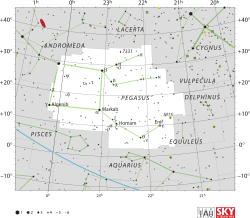Theta Pegasi

| |
| Observation data Epoch J2000.0 Equinox J2000.0 | |
|---|---|
| Constellation | Pegasus |
| Right ascension | 22h 10m 11.98528s[1] |
| Declination | +06° 11′ 52.3078″[1] |
| Apparent magnitude (V) | +3.53 |
| Characteristics | |
| Spectral type | A2V[2] |
| Astrometry | |
| Radial velocity (Rv) | −7.90[3] km/s |
| Proper motion (μ) | RA: +282.18[1] mas/yr Dec.: +30.46[1] mas/yr |
| Parallax (π) | 35.34 ± 0.85[1] mas |
| Distance | 92 ± 2 ly (28.3 ± 0.7 pc) |
| Details | |
| Mass | 1.848[2] M☉ |
| Radius | 2.6225±0.0829[2] R☉ |
| Luminosity | 23.7012±1.1418[2] L☉ |
| Temperature | 7872±82[2] K |
| Metallicity [Fe/H] | −0.38[2] dex |
| Age | 1.1[2] Gyr |
| Other designations | |
Theta Pegasi (θ Pegasi, abbreviated Theta Peg, θ Peg), also named Biham,[4] is a star in the constellation of Pegasus.
Nomenclature
θ Pegasi (Latinised to Theta Pegasi) is the star's Bayer designation.
It bore the traditional name Biham or Baham from the Arabic phrase s'ad al Biham "Lucky Stars of the Young Beasts".[5] In 2016, the International Astronomical Union organized a Working Group on Star Names (WGSN)[6] to catalogue and standardize proper names for stars. The WGSN approved the name Biham for this star on 21 August 2016 and it is now so entered in the IAU Catalog of Star Names.[4]
In Chinese, 危宿 (Wēi Sù), meaning Rooftop, refers to an asterism consisting of Theta Pegasi, Alpha Aquarii and Epsilon Pegasi.[7] Consequently, Theta Pegasi itself is known as 危宿二 (Wēi Sù èr, English: the Second Star of Rooftop.)[8]
Properties
Theta Pegasi is of spectral class A2 and has apparent magnitude +3.53. It is approximately 97 light years from Earth. This star has 2.6 times the Sun's radius and it is radiating 25 times the luminosity of the Sun from its outer envelope at an effective temperature of 7,951 K.[9]
References
- 1 2 3 4 5 van Leeuwen, F. (2007), "Validation of the new Hipparcos reduction", Astronomy and Astrophysics, 474 (2): 653–664, arXiv:0708.1752
 , Bibcode:2007A&A...474..653V, doi:10.1051/0004-6361:20078357.
, Bibcode:2007A&A...474..653V, doi:10.1051/0004-6361:20078357. - 1 2 3 4 5 6 7 Boyajian, Tabetha S.; et al. (July 2013), "Stellar Diameters and Temperatures. III. Main-sequence A, F, G, and K Stars: Additional High-precision Measurements and Empirical Relations", The Astrophysical Journal, 771 (1): 31, arXiv:1306.2974
 , Bibcode:2013ApJ...771...40B, doi:10.1088/0004-637X/771/1/40, 40. See Table 3.
, Bibcode:2013ApJ...771...40B, doi:10.1088/0004-637X/771/1/40, 40. See Table 3. - ↑ Gontcharov, G. A. (November 2006). "Pulkovo Compilation of Radial Velocities for 35 495 Hipparcos stars in a common system". Astronomy Letters. 32 (11): 759–771. Bibcode:2006AstL...32..759G. doi:10.1134/S1063773706110065.
- 1 2 "IAU Catalog of Star Names". Retrieved 28 July 2016.
- ↑ Kaler
- ↑ IAU Working Group on Star Names (WGSN), International Astronomical Union, retrieved 22 May 2016.
- ↑ (Chinese) 中國星座神話, written by 陳久金. Published by 台灣書房出版有限公司, 2005, ISBN 978-986-7332-25-7.
- ↑ (Chinese) 香港太空館 - 研究資源 - 亮星中英對照表, Hong Kong Space Museum. Accessed on line November 23, 2010.
- ↑ Boyajian, Tabetha S.; et al. (February 2012), "Stellar Diameters and Temperatures. I. Main-sequence A, F, and G Stars", The Astrophysical Journal, 746 (1): 101, arXiv:1112.3316
 , Bibcode:2012ApJ...746..101B, doi:10.1088/0004-637X/746/1/101. See Table 10.
, Bibcode:2012ApJ...746..101B, doi:10.1088/0004-637X/746/1/101. See Table 10.